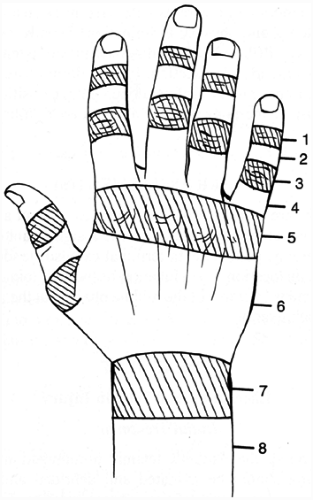Extensor Tendon Injuries
General Information
Tendon Laceration
The extensor tendons are divided into eight zones (Fig. 1). Odd-numbered zones are on the joints and even zones are between the joints. Zone 1 is over the distal interphalangeal (DIP) joint.
The extensor mechanism is a finely balanced system that requires two muscles to extend three joints. Elongation or shortening over the digit as little as 3 mm may produce significant changes in the range of motion.
Partial Tendon Laceration
Tendon lacerations of less than 50% of the diameter of the tendon are usually asymptomatic and do not need repair; however, when a partial laceration occurs at the central slip insertion, failure to repair it will lead to palmar subluxation of the lateral bands (boutonniere).
Mallet Finger
A mallet finger is loss of active extension of the DIP joint. There are three causes of a mallet finger: tendon transection distal to the proximal interphalangeal (PIP) joint, tendon avulsion from the distal phalanx, and fracture of the distal phalanx with associated loss of extensor insertion site. With proximal retraction of the extensor apparatus, there can be associated PIP joint extension (swan neck deformity).
Boutonniere Injury
A boutonniere deformity is loss of active extension of the PIP joint with subsequent hyperextension of the DIP joint. There are three causes of a boutonniere deformity in the finger: tendon transection between the metaphalangeal (MP) and PIP joints, tendon avulsion from its insertion into the base of the middle phalanx,
and fracture of the dorsal lip of the middle phalanx with associated loss of extensor continuity. When a boutonniere injury occurs, the extensor apparatus retracts proximally and the lateral bands translate to a position that is now below the axis of PIP joint rotation, making them flexors of the PIP joint. As they move in a palmar direction, they also cause increased tension on the DIP joint, which increases resting extension in the DIP joint.
and fracture of the dorsal lip of the middle phalanx with associated loss of extensor continuity. When a boutonniere injury occurs, the extensor apparatus retracts proximally and the lateral bands translate to a position that is now below the axis of PIP joint rotation, making them flexors of the PIP joint. As they move in a palmar direction, they also cause increased tension on the DIP joint, which increases resting extension in the DIP joint.
Diagnostic Criteria
Laceration of the extensor surface of the wrist, hand, and forearm can be complicated by tendon transection because the extensor mechanism is very close to the skin on the dorsum of the hand. The extensor tendon can also be ruptured by forcibly flexing a digit that is trying to extend (closed mallet injury, closed boutonniere injury). Establish the status of tetanus immunization if a laceration has been sustained.
Stay updated, free articles. Join our Telegram channel

Full access? Get Clinical Tree








